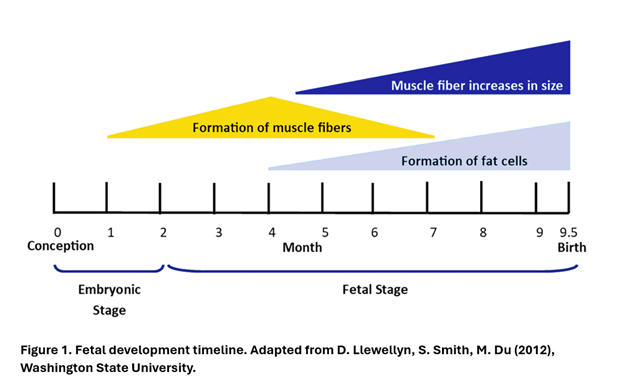Feeding for the future: Maternal protein intake
Posted on February 16, 2024
Source: Farm Progress. The original article is posted here.

By Madison Kovarna, South Dakota State University Extension
For 75% of the year, beef producers are generally feeding two animals— the cow and her unborn calf. Additionally, a cow may be growing a fetus while nursing a calf at her side. Maternal nutrition is extremely important not only to the cow, but also to her unborn calf, which relies solely on its mother for nutrition. Maternal nutrition can affect offspring performance by altering fetal development. Muscle fibers and fat cells that are formed during gestation set the stage for a calf’s future performance.
For example, Figure 1 indicates the months of gestation where muscle fibers and fat cells are forming. If developing calves experience a nutrient deficiency during this period, it may reduce muscle fiber number and subsequent muscle mass in offspring. This can lead to lower cutability of a carcass once the calf reaches market weight.

Steer calf performance
An animal’s phenotype is determined by the genes inherited from its parents, but also environmental factors. These factors include nutrition, weather, and various other variables that can impact that animal’s performance potential. A study conducted at the University of Wyoming 1 studied the impact of maternal nutrition on future calf performance. They examined maternal protein nutrition during mid-gestation. One group grazed 6% crude protein native pastures, while the other grazed 11% crude protein irrigated and fertilized pastures. At the conclusion of the study, they reported that calves born to dams who grazed lower-quality pastures produced offspring that had lighter carcass weights and produced less-tender steaks.
Heifer calf performance
Performance of female offspring in the breeding herd can also be impacted by maternal nutrition. Researchers at the University of Nebraska 2 reported that dams grazing dormant range or corn residue during late gestation that were offered a supplemental protein source produced heifers that attained puberty earlier and had higher pregnancy rates compared to offspring from non-supplemented dams. In a similar study, researchers reported that heifer offspring from protein-supplemented dams were more likely to calve in the first 21 days of the calving season. 3
The bottom line
Feed costs for a pregnant female during the winter months can be extremely high, and feed can be difficult to source. Even though it may be tempting to cut corners where possible, it is important to not limit feed resources to gestating females. Limiting the dam on her nutritional needs has the potential to influence offspring performance far into the future. As always, discuss nutritional plans and concerns with an extension specialist or beef nutritionist to determine the best course of action for your herd.
Sources

.jpg?disable=upscale&width=1200&height=630&fit=crop)


